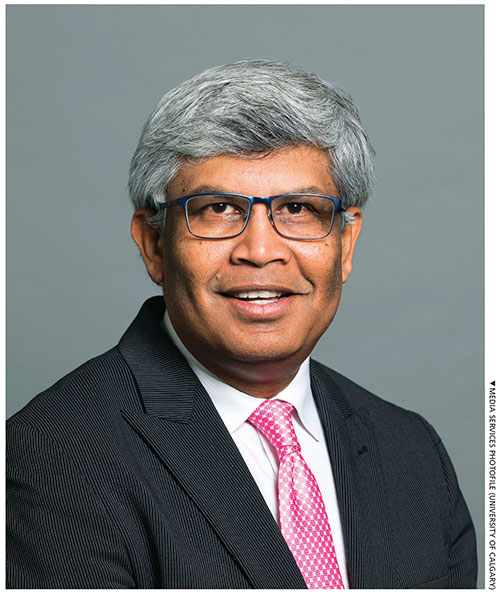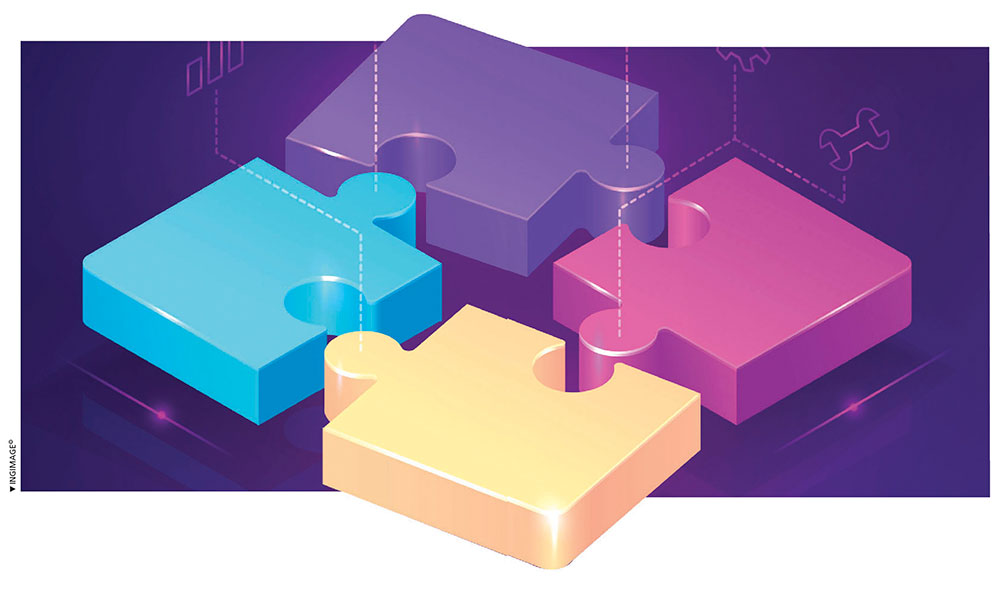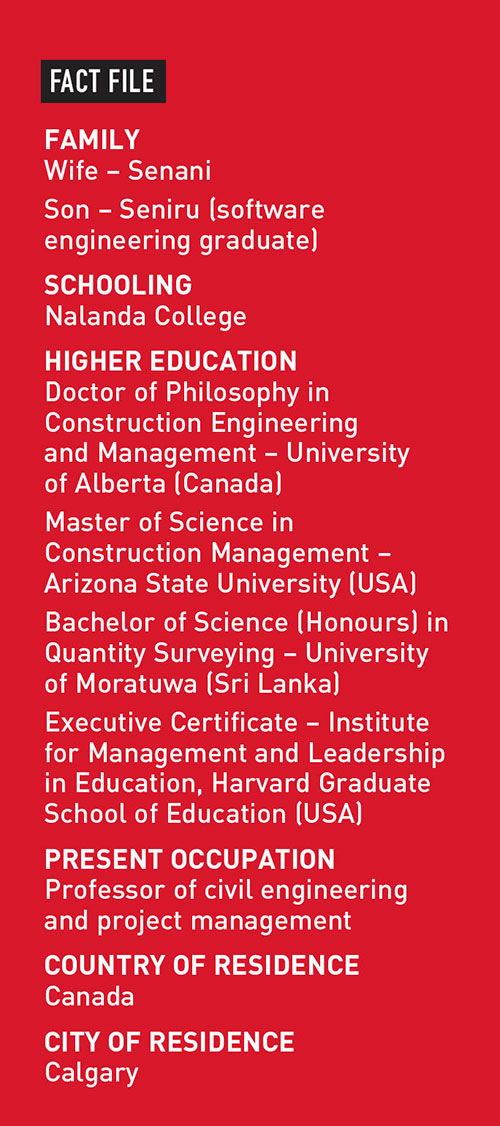Prof. Janaka Ruwanpura

Shape future ready infrastructure
Prof. Janaka Ruwanpura is an award-winning academic leader, administrator and expert in project management. A professor at the University of Calgary in Canada, and a former Vice-Provost and Associate Vice President Research (International) for over 11 years, he has led transformative internationalisation and research initiatives, earning wide recognition – including being named one of Canada’s Top 25 Immigrants in 2022.
A licensed professional engineer and quantity surveyor, and a fellow of multiple national academies, he is widely respected for advancing research, innovation, and practical tools and models.
Ruwanpura is also recognised for fostering global partnerships, and strengthening capacity in engineering project management and higher education, across Canada and beyond.
Q: Your academic and professional journey has taken you from Moratuwa to Arizona, Alberta and finally, Calgary. What inspired you to pursue civil engineering and project management?
A: Growing up, I was fascinated by how infrastructure transforms societies and improves the quality of life. My passion for solving problems and creating a lasting impact drew me towards civil engineering.
I narrowly missed the marks needed to pursue civil engineering at university. So I built a solid educational and technical foundation in quantity surveying at the University of Moratuwa instead.
My graduate studies in Arizona and Alberta further enhanced my interest and expertise in construction engineering, civil engineering and project management.
Ultimately, I became a professor of civil engineering and project management, earning credentials as both a professional quantity surveyor and engineer in Canada.
Q: What did being recognised as one of 2022’s Top 25 Canadian Immigrants mean to you personally and professionally?
A: It was a truly meaningful milestone. On a personal level, it allowed me to reflect on the sacrifices and resilience that have shaped my journey. Professionally, it validated years of dedication in academia, leadership and international engagement.
The accolade also provided a platform to inspire others – especially newcomers – to pursue excellence, embrace opportunities and contribute to Canada’s growth.
Q: How have your innovations in construction productivity and risk management been applied practically in the profession?
A: My innovations have consistently bridged research with real-world impact.
I developed the RiSQ framework, which enables project teams to systematically identify, assess and respond to risks, supported by an integrated simulation platform that visualises cost and schedules scenarios. This approach has improved project predictability and performance.
Through the Top Ten Targets for Improving Construction Productivity initiative, my research team produced over 30 best practices and tools including the i-Booth – a commercialised digital information kiosk – and a new site leadership role, the Construction Productivity Improvement Officer (CPIO), which has been implemented in projects well beyond Canada.
Q: Tell us about your work with the International Institute for Infrastructure Renewal and Reconstruction (IIIRR). How has disaster resilience in infrastructure evolved?
A: The IIIRR was founded in response to the 2004 Asian tsunami to address rebuilding challenges through international cooperation. My work with IIIRR focussed on enhancing disaster resilient infrastructure through research, training and policy discussion.
Over time, disaster resilience has shifted from reactive rebuilding to proactive planning, with an emphasis on risk reduction, community involvement and adaptive infrastructure systems.
IIIRR has greatly contributed to this global shift through interdisciplinary and cross-regional collaborations.
Q: What are the challenges currently facing the global construction industry?
A: The construction industry faces multiple interconnected challenges.
First, supply chain disruptions and raw material shortages continue to raise costs and cause delays.
Second, labour shortages – especially in skilled trades – remain a persistent obstacle, worsened by an ageing workforce and low interest among youth.
And third, the need to reduce carbon emissions calls for greener materials, sustainable practices and regulatory standards, yet progress is slow.
Lastly, digital transformation is uneven: while new tools are emerging, many companies struggle with integration, data handling and cybersecurity.
Solving these issues needs coordinated investments, education reforms and international standards, to build resilience and foster innovation.

Q: How do you see the construction and infrastructure industry evolving, in response to climate change and sustainability demands?
A: The industry is rapidly evolving to meet climate change and sustainability requirements.
There is a strong shift towards low carbon materials, circular construction models and nature based solutions such as biomimicry. Net zero buildings, renewable energy and climate resilient design are becoming standard practices.
Digital tools including digital twins and AI powered analytics help enhance performance throughout the lifecycle. Moreover, green finance and environment, social and governance (ESG) reporting now influence investment decisions.
The industry must embrace collaboration, innovative policies and workforce upskilling, to create infrastructure that is both sustainable and resilient for the future.
Q: What skills are most in demand for today’s engineers and project managers – and how can academic programmes better prepare graduates?
A: Today’s engineers must possess strong technical skills, digital literacy and systems thinking to manage complex technology driven environments. For project managers, essential skills include leadership, risk management, stakeholder engagement and strategic decision-making.
Academic programmes should combine theory with practical learning, industry partnerships and interdisciplinary exposure. For engineers, this involves labs and simulations; for aspiring project managers, mentoring, internships and real world case studies help connect academic knowledge to practical leadership skills.
Q: How can developing countries adopt best practices in project management and infrastructure planning from nations such as Canada?
A: Developing countries can adopt best practices by localising proven frameworks in project management, risk assessment and infrastructure planning. Key steps include investing in capacity building, adopting transparent procurement systems, and integrating tools such as digital project controls and risk based planning.
Knowledge exchange through academic partnerships, professional training and pilot projects can support adaptation. Emphasis should be placed on sustainability, community engagement and long-term value. Policies must also align with governance and institutional capacity to ensure successful implementation.
Sri Lanka should build robust research intensity in its universities and establish sustainable research funding mechanisms. Collaboration among government, academia and industry is crucial, to drive systemic change and foster local expertise.

Q: How would you assess the preparedness of Sri Lankan engineering graduates for the international job market?
A: They are technically competent and highly adaptable, but gaps remain in soft skills, practical experience, global exposure and digital proficiency.
Although their academic foundations are strong, limited integration with industry and outdated curricula hinder international competitiveness. Improving experiential learning, communication skills and global awareness through internships, industry collaborations and curriculum updates will better equip graduates to succeed in diverse innovation driven work environments and meet changing global standards.
I also suggest that Sri Lankan universities establish academic exchange and research internship programmes with international institutions to better prepare students for international careers.
Q: What type of platforms or partnerships would you recommend to foster collaboration between Sri Lankan universities and international institutions?
A: To foster meaningful collaboration, Sri Lankan universities should pursue strategic partnerships through dual degree programmes, research consortia and exchange initiatives, for both students and faculty.
Platforms such as joint research centres, co-funded projects and global innovation hubs can promote mutual benefits. Engaging diaspora academics and international professional bodies also helps expand networks. And active participation in global rankings and benchmarking systems can boost visibility.
Above all, partnerships must be structured, long-term and aligned with shared priorities, focussing on research excellence, capacity building and student mobility.

Q: And how can Sri Lanka position itself as a regional leader in engineering innovation or project management excellence?
A: Sri Lanka can establish itself as a regional leader by leveraging academic talent, expanding research capacity and fostering industry-academia collaboration.
Focussing on niche areas such as climate resilient infrastructure, sustainable construction and digital project management can create competitive advantages.
Investing in innovation hubs, forming global partnerships and developing talent are vital. Meanwhile, streamlining policies, promoting entrepreneurship and showcasing local success stories on international platforms will also boost credibility.
A national strategy centred on excellence, innovation and global engagement can improve Sri Lanka’s regional standing.

